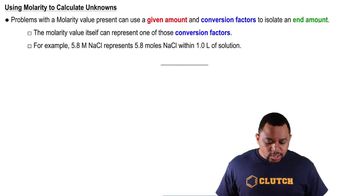A glucose solution contains 74.2 g of glucose (C6H12O6) in 455 g of water. Determine the freezing point and boiling point of the solution.
What mass of salt (NaCl) should you add to 1.00 L of water in an ice cream maker to make a solution that freezes at -10.0 °C? Assume complete dissociation of the NaCl and density of 1.00 g/mL for water.
 Verified step by step guidance
Verified step by step guidance
Verified Solution
Key Concepts
Freezing Point Depression

Colligative Properties

Molarity and Density

Calculate the freezing point and boiling point of each aqueous solution, assuming complete dissociation of the solute. a. 0.100 m K2S b. 21.5 g of CuCl2 in 4.50⨉102 g water
Calculate the freezing point and boiling point of each aqueous solution, assuming complete dissociation of the solute. c. 5.5% NaNO3 by mass (in water)
Use the van't Hoff factors in Table 13.9 to calculate each colligative property: a. the melting point of a 0.100 m iron(III) chloride solution
A 1.2 m aqueous solution of an ionic compound with the formula MX2 has a boiling point of 101.4 °C. Calculate the van't Hoff factor (i) for MX2 at this concentration.
A 0.100 M ionic solution has an osmotic pressure of 8.3 atm at 25 °C. Calculate the van't Hoff factor (i) for this solution.
